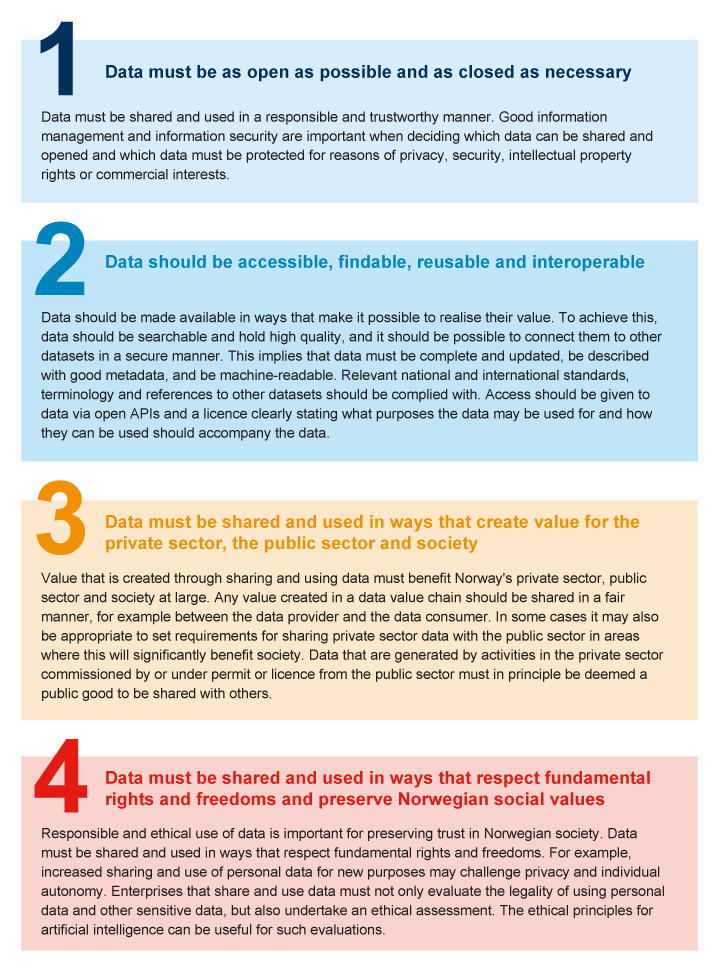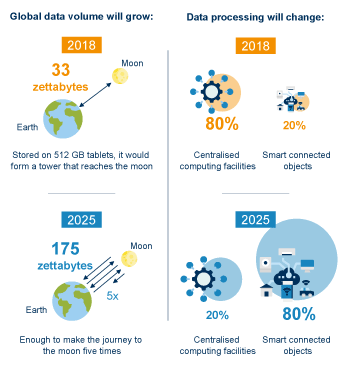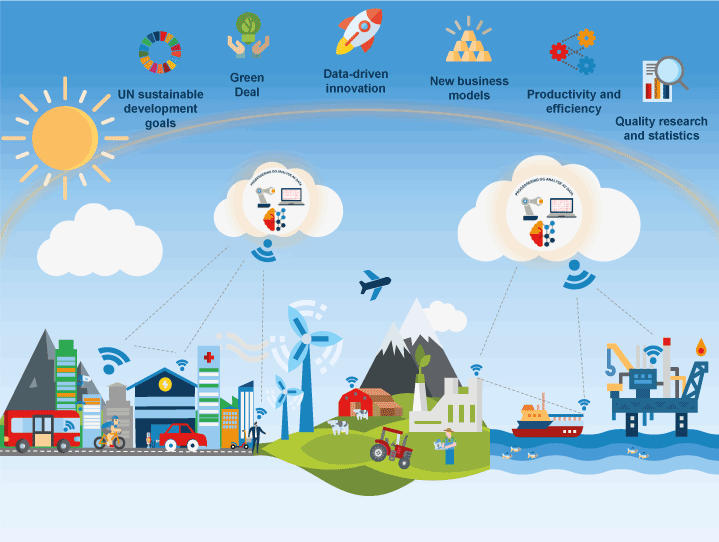1 Introduction
1.1 The Government’s goals and ambitions
The purpose of this report to the Storting is to present the Government’s policy for value creation using data as a resource. The Government wants Norway to leverage the potential of data to enhance value creation, create new jobs, and to improve public sector efficiency. Better use of data is important if Norway is to succeed in the transition to a more sustainable society and a greener economy.
The emergence of the data economy is expected to be a key driver of economic growth. The data economy is defined as value creation based on data as an essential input factor in the production of goods and services or when data constitute a driver of innovative solutions.
The Government’s ambition is to see increased data sharing within the private sector and between the private and public sectors. Data now account for an increasing proportion of value creation in most Norwegian industries and sectors, but the private sector must become even better at using its own data and at sharing data with others. Greater access to and better use of data within the private sector can help start-ups, growth companies and established businesses develop new business models, products and services. This in turn can help make Norwegian business and industry more competitive, both nationally and internationally.
The public sector must make more data available to the private sector. Reuse of public sector information is about giving businesses, researchers and civil society access to data from the public sector in ways that allow the data to be used in new contexts. Better use of data from private or public sources can lead to better services, new insights or other value-creating activities and products.
More public sector information should be shared, and the quality improved, in order to make it easier to reuse data in new contexts. Norway is falling in international rankings for public availability and sharing of data. Norway was ranked no. 29 in the EU’s Open Data Maturity survey for 2020. In 2017 Norway was ranked no. 9 in the same survey. The Government will facilitate a more efficient and secure digital infrastructure for sharing and reusing public sector information. A sound regulatory framework and sufficiently strong incentives for data sharing must be established, as well as models that ensure that data sharing benefits society.
The education and research system must be designed to give the labour market access to the necessary knowledge and competence in and for the data economy. Having the right type and level of competence is vital for creating value using data as a resource. To meet the demand for skills in the labour market, there will be a need to provide more candidates with specialist ICT education and to give those already active in the labour market opportunities to develop their skills through further education and other courses.
The Government will facilitate a responsible data economy in Norway and work to ensure that data is used in fair, ethical and responsible ways. Security and privacy must be safeguarded. Consumers’ rights must be protected, and fair competition rules for Norwegian and international businesses facilitated. Artificial intelligence and big data analytics can help make services better adapted to individual needs. It is also important to prevent discrimination, data manipulation and misuse. Transparency, equal treatment and legal certainty are important democratic principles that must also apply in the data economy.
Many of the challenges of the data economy must be resolved through international cooperation. This includes ensuring fair competition and regulating the activities of multinational companies in the data economy. One of the key priorities in the Government’s national IT policy is that Norway should be an integrated part of, and active participant in, the Digital Single Market in Europe.
More efficient use of data as a resource will also help Norway succeed in the transition to a more sustainable society and a greener economy. The European Commission’s data strategy and digital strategy from February 2020 explicitly express the importance of having a common digital policy in the EU. The overarching goals for the digital strategy are that Europe’s digital development should benefit both people and the environment, align with the European Union’s social principles, and advance the objectives of the European Green Deal for a sustainable, climate-neutral and resource-efficient economy. Norway faces the same major challenges as the EU. There is therefore no reason why Norway should have lower ambitions in this area than the rest of Europe.
Norway is well placed to take on an active role in the data economy.
Norway is well placed to take on a more active role in the global data economy. In the past 10 years, Norway has established several national measures and policy instruments to promote the sharing and use of public sector information (data) in order to facilitate a more efficient public sector, innovation, research and business development.
Norway is at the forefront of digitalisation in both the public and private sectors. The country has a robust economy, competent industrial and technology communities, and a population of early adopters of new digital technologies. In Europe, only Denmark and Luxembourg have more digitally literate populations than Norway.1 Along with Denmark, Norway has the best mobile and broadband access in Europe.2
Many of Norway’s public services are already digitalised, and national registers and many public data sets hold a high standard. These are valuable data that must be managed properly and responsibly if they are to benefit society.
The fact that Norway has many good public registers is also linked to the population’s consistently high level of trust in the authorities’ management of the data collected. A high-trust society and good cooperation between the authorities, employers and unions, academia and research communities are important advantages which Norway must leverage and preserve while the data economy is developing.
1.2 National principles for data sharing and use
The Government sets the following principles for its data policy; see Figure 1.1:
Data must be as open as possible and as closed as necessary.
Data should be findable, accessible, interoperable and reusable (FAIR).
Data must be shared and used in ways that create value for the private sector, the public sector and society.
Data must be shared and used in ways that respect fundamental rights and freedoms and preserve Norwegian social values.
The Government’s principles for data policy should underpin efficient sharing and use of data within safe and responsible parameters, and should ensure that value created from data benefits the private sector, the public sector and society. The principles should also facilitate mutual trust between entities that share and use each other’s data, and public trust that data will be shared and used to the benefit of society.
The principles are founded on applicable legal requirements and policy guidelines within the EU and the OECD, as well as in Norway. The principles must also be practised in accordance with Norway’s international trade agreements. The principles shall not prevent public sector organisations from charging for data, and the choice of funding models for sharing and use of data for reuse in different sectors must be respected.

Figure 1.1 National principles for data sharing and use
1.3 The data economy and data as a resource
The value of the data economy
The data economy has vast potential for growth in the coming years. In its data strategy (2020), the European Commission projects the value of the data economy in EU27 will increase from EUR 301 billion in 2018 to EUR 829 billion by 2025. In 2020 Norway’s data economy was estimated to account for annual value creation equivalent to NOK 150 billion and for 100,000 jobs. If the right conditions are created, these figures could double by 2030.3
Technologies such as artificial intelligence and big data analytics facilitate value-adding activities that were not previously possible. See Box 1.1 for an overview of important technology drivers in the data economy.

Figure 1.2 Expected changes in data volume and data processing
Source European Commission (2020)
Technological development has driven fundamental changes in manufacturing, service provision and digital collaboration, and large amounts of data are today generated from many different sources. The European Commission considers industrial and commercial data to have the greatest value-creating potential for the private sector and for society.4 This is largely because the already large data volumes from industrial and commercial applications will continue to increase. Increased sharing and better use of the data will increase value creation. Industrial data comprise data from sensors and control systems in manufacturing, maintenance scheduling systems and equipment data. Commercial data can comprise customer data, transactions, and so forth. In line with development of new digital services and platforms that target consumers, several commercial service providers also collect, use and share consumer data. These data are bought and sold in large volumes and used for purposes such as targeted marketing and improvement of products and services. When it comes to data sharing and use, an important distinction is drawn between personal data and data that cannot identify specific individuals. The General Data Protection Regulation sets rules for the processing of personal data; see chapter VII.
Textbox 1.1 Technology drivers in the data economy
Cloud computing
Cloud computing refers to data storage and processing performed outside an enterprise, usually in large data centres. A common feature of cloud services is that they are paid for according to capacity used. Cloud computing is often provided by large international companies which also offer additional services such as security, statistics and analyses, machine learning, etc. For many companies cloud services are necessary to leverage the potential of data science and artificial intelligence because they provide access to computing power and frameworks for machine learning that cannot be established locally.
Sensor technology and the Internet of Things (IoT)
The Internet of Things (IoT) refers to objects (‘things’) that have sensors, software and communication technology that allow them to communicate with other objects connected to the internet. Gradually, as developments in sensor technology have provided better, smaller and cheaper sensors, and as technologies for wireless communication have improved, this network of things has grown. Various sources estimate that at the end of 2020, between 20 and 30 billion objects were connected to the internet. The data volume generated by such objects has therefore grown enormously in recent years.
When these objects are used in services that depend on computing in real time, such as autonomous vehicles or advanced manufacturing processes, the data processing must often be performed locally on the object (edge computing); that is, in the actual vehicle or the industrial sensor network. Such networks will often use 5G for fast and secure communication. As edge computing becomes more widespread and data volumes increase, a significantly smaller proportion of the total data volume will be processed in cloud services and centralised systems; see Figure 1.2.
Big data analytics
Big data analytics is the analysis of large data volumes composed of many different data sources with structured, unstructured and real-time data. The purpose is to find new interrelations and insights that cannot be derived through traditional methods of data analytics. Examples of areas that may benefit from this are medical diagnostics, consumer behaviour or crime prevention.
Artificial intelligence
Artificial intelligence is a collective term for information technologies where machine learning, machine reasoning and robotics are key elements. Artificial intelligence systems perform actions, physically or digitally, based on interpreting and processing structured or unstructured data. Artificial intelligence can also ‘learn’ and adapt by analysing and taking into account the effects of previous actions on the environment. Some examples of practical applications of artificial intelligence are pattern recognition, language technology and autonomous vehicles. Access to high-quality data is essential to leverage the potential of artificial intelligence.
High performance computing (HPC)
In many areas where work is performed on large datasets, the need for computing power to process data far exceeds what any enterprise can establish alone or procure through traditional cloud services. HPC will become increasingly important for industry and for the public sector, for example in connection with analysing the vast datasets generated by DNA sequencing, satellite observation or climate modelling. Norwegian research organisations and businesses have access to HPC facilities under the European High Performance Computing Joint Undertaking (EuroHPC).
Textbox 1.2 Key terms
Data essentially means any physical representation of information, knowledge, opinions, etc., and can be unstructured or structured. Data form the basis for information, but the distinction between data and information is not always clear.
Structured data are usually found organised in a database, list or table. Unstructured data is everything else, such as images, audio files, films, e-mails, documents and other information that is not organised. Between 70 and 90 per cent of all data is estimated to be unstructured.
A dataset is a collection of data in the form of, for example, a table, list or database that can be made available as a downloadable file and/or be accessed via an application programming interface (API).
A data catalogue is a structured collection of descriptions of datasets. A data catalogue makes it possible to find information about datasets, who administers the data and how the data are made available to others. Data.norge.no is an example of a data catalogue.
Data sharing is where an enterprise makes data available for use by one or more other enterprises, public and/or private, with or without terms of use (licences).
A data producer generates data through its activity. A data provider shares its own data or that of others with one or more parties. In many cases the same enterprise can act as both data producer and data provider. A data consumer (data user) uses its own data and/or that of others in processes, products, services, analyses or for other purposes.
Open data refers to information that is made accessible so that it can be read and interpreted by machines and humans and which everyone can access, use and share. Closed data refers to information only authorised and authenticated users have access to. Access to the data may be restricted for commercial or privacy reasons.
Important characteristics of data as a resource
Data are collectively referred to as non-rival goods. This means that data can be used and reused repeatedly, for example in algorithms and programmes. Data are thus often worth more if they are shared.
Combining different datasets can provide greater insights and form a basis for greater value creation than a single dataset. Increased sharing and use of data can generate new knowledge and alternative solutions that can be of greater benefit to society than if access to the data is confined to the individual data owner.
Data use generates economies of scale. Combining two complementary datasets can provide more insights than individual datasets, and it can be more efficient to process large datasets than to process datasets separately. Nonetheless, large datasets or data sharing alone will not create value. Data can only create value when they are placed in a context, analysed and processed.
Nor is it the case that datasets are either open and accessible to everyone or closed. The OECD employs different levels of openness and accessibility, from data restricted to individual enterprises, via data that are available to specific stakeholders or user groups, to data that are publicly available. Data can be accessible to different groups on different terms and at different times.
For many enterprises, creating value from data is about gaining an overview of and using their own data in order to improve, renew or innovate. It is estimated that approximately 90 per cent of value created from data is related to increased productivity in existing businesses and public sector organisations, while five per cent is related to innovation.5
Figure 1.3 presents a simplified description of how different types of data can be collected from different sources that are connected to the internet. The data are stored, processed and analysed in digital computer platforms ‘in the cloud’. These platforms can be provided by the public sector, businesses, or by both in partnership.

Figure 1.3 Value creation using data as a resource
New insight can be derived from the analyses. This insight can be used by the enterprises to improve, renew or innovate. Better use of data as a resource can, for example, contribute to managing some of the major societal challenges the world faces, and to generating new business opportunities and economic growth for individual companies.
Footnotes
OECD (2017): Digital Government Review of Norway. Boosting the Digital Transformation of the Public Sector and SSB (2020): ICT usage in households www.ssb.no/ikthus
European Commission (2020): The Digital Economy and Society Index (DESI)
Menon Economics (2019) Er verdiskaping med data noe Norge kan leve av? [Can Norway live off value creation from data?] Menon publication no. 88/2019. 88/2019
Communication from the Commission to the European Parliament, the Council, the European Economic and Social Committee and the Committee of the Regions A European strategy for data COM/2020/66 final
Menon Economics (2019) Er verdiskaping med data noe Norge kan leve av? [Can Norway live off value creation from data?] Menon publication no. 88/2019. 88/2019